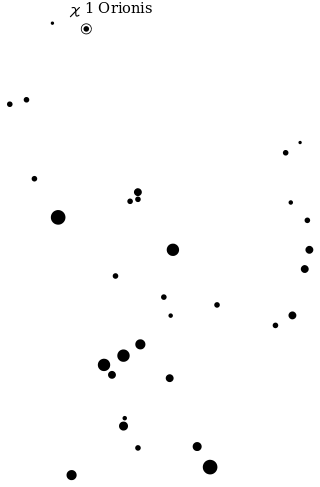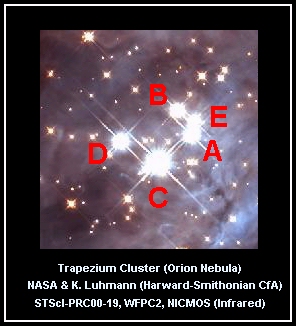Related Research Articles

Mintaka, designation Delta Orionis and 34 Orionis, is a multiple star system some 1,200 light-years from the Sun in the constellation of Orion. Together with Alnitak and Alnilam, the three stars form Orion's Belt, known by many names among ancient cultures. The star is located very close to the celestial equator. When Orion is near the meridian, Mintaka is the rightmost of the Belt's stars when viewed from the Northern Hemisphere facing south.

Bellatrix is the third-brightest star in the constellation of Orion, positioned 5° west of the red supergiant Betelgeuse. It has the Bayer designation γ Orionis, which is Latinized to Gamma Orionis. With a slightly variable magnitude of around 1.6, it is typically the 25th-brightest star in the night sky. Located at a distance of 250±10 light-years from the Sun, it is a blue giant star around 7.7 times as massive as the sun with 5.75 times its diameter.

In stellar evolution, an FU Orionis star is a pre–main-sequence star which displays an extreme change in magnitude and spectral type. One example is the star V1057 Cyg, which became six magnitudes brighter and went from spectral type dKe to F-type supergiant during 1969-1970. These stars are named after their type-star, FU Orionis.

Iota Orionis is a multiple star system in the equatorial constellation of Orion the hunter. It is the eighth-brightest member of Orion with an apparent visual magnitude of 2.77 and also the brightest member of the asterism known as Orion's Sword. It is a member of the NGC 1980 open cluster. From parallax measurements, it is located at a distance of roughly 1,340 light-years from the Sun.

Chi1 Orionis is a star about 28 light years away. It is in the constellation Orion, where it can be seen in the tip of the hunter's upraised club.

Meissa, designated Lambda Orionis is a star in the constellation of Orion. It is a multiple star approximately 1,300 ly away with a combined apparent magnitude of 3.33. The main components are an O8 giant star and a B-class main sequence star, separated by about 4″. Despite Meissa being more luminous and only slightly further away than Rigel, it appears 3 magnitudes dimmer at visual wavelengths, with much of its radiation emitted in the ultraviolet due to its high temperature.

Eta Orionis or Algjebbah, Latinized from η Orionis, is a multiple star in the constellation Orion. It lies a little to the west of Orion's Belt between Delta Orionis and Rigel, being closer to Delta Orionis than to Rigel. It lies at a distance of around 1,000 light-years from Earth and is part of the Orion OB1 association.

Z Canis Majoris (Z CMa) is a B-type star in the constellation of Canis Major. It has an average apparent visual magnitude of approximately 10, though has brightened by 1-2 magnitudes in irregular outbursts in 1987, 2000, 2004 and 2008.

FU Orionis is a variable and binary star system in the constellation of Orion, that in 1937 rose in apparent visual magnitude from 16.5 to 9.6, and has since been around magnitude 9. The name FU Orionis is a variable star designation in the Argelander system, which are assigned sequentially as new variables are discovered. FU Orionis is about 1,360 light years distant and is associated with the molecular cloud Barnard 35.

V1057 Cygni is a suspected binary star system in the northern constellation of Cygnus. It is a variable star of the FU Orionis-type, and was the second FU Orionis-type variable to be discovered. The system is located at a distance of approximately 3,000 light years from the Sun, in the North America Nebula. It has an apparent visual magnitude of around 12.4.

U Orionis is a Mira-type variable star in the constellation Orion. It is a classical long period variable star that has been well observed for over 120 years.

25 Orionis, less commonly known by its Bayer designation Psi1 Orionis is a fifth-magnitude star in the constellation Orion. It lies among a dense cluster of low-mass pre-main-sequence stars in the Orion OB1a.

Chi2 Orionis is a B-type supergiant star in the constellation of Orion. It has an apparent visual magnitude of 4.63 but being quite distant, and heavily extinguished it burns with the greatest absolute visual light magnitude among stars in Orion within the near reaches of the galaxy, 0.9 of a magnitude brighter than Rigel. Since 1943, the spectrum of this star has served as one of the stable anchor points by which other stars are classified. It is considered to be a member of the Gemini OB1 association.

Xi Orionis is a binary star system in the northeastern part of the constellation of Orion, well above the red giant star Betelgeuse in the sky. It lies next to another blue main-sequence star, Nu Orionis, which is somewhat closer at 520 light-years' distance. The apparent visual magnitude of Xi Orionis is 4.47, which is bright enough to be seen with the naked eye. The distance to this star, as determined using the parallax method, is roughly 610 light-years.
Scott Jay Kenyon is an American astrophysicist. His work has included advances in symbiotic and other types of interacting binary stars, the formation and evolution of stars, and the formation of planetary systems.

32 Orionis is a triple star system in the equatorial constellation of Orion. It has the Bayer designation A Orionis, while 32 Orionis is the Flamsteed designation. This system is visible to the naked eye as a faint point of light with a combined apparent visual magnitude of 4.20. It is located approximately 303 light-years away from the Sun based on parallax, and is drifting further away with a radial velocity of +18.6 km/s.

69 Orionis is a single star in the equatorial constellation of Orion, positioned a couple of degrees to the north of Xi Orionis. It has the Bayer designation f1 Orionis; 69 Orionis is the Flamsteed designation. The star is visible to the naked eye as faint, blue-white hued point of light with an apparent visual magnitude of 4.92. It is located approximately 530 light-years from the Sun based on parallax, and is drifting further away with a radial velocity of +22 km/s. In 2015, H. Bouy and J. Alves suggested that it is a member of the newly discovered Taurion OB association.

Theta1 Orionis A is a variable trinary star in the constellation Orion. Its apparent magnitude range is 6.72 to 7.65 with a period of 65.432 days. It is one of the main stars in The Trapezium in Orion, along with B, C, and D, as well as the fainter E.
74 Orionis is a single star in the equatorial constellation of Orion. It has the Bayer designation k Orionis, while 74 Orionis is the Flamsteed designation. This object is visible to the naked eye as a faint, yellow-white hued point of light with an apparent visual magnitude of 5.04. It is located at a distance of 64 light years from the Sun based on parallax, and is drifting further away with a radial velocity of +9 km/s. The star has a relatively high proper motion, traversing the celestial sphere at the rate of 0.204 arc seconds per annum.

BF Orionis is a young Herbig Ae/Be star in the constellation of Orion about 1250 light years away, within the Orion Nebula. It is the most massive star of the small birth cluster of four stars.
References
- ↑ "Stacie Powell Bio, Stats, and Results". Olympics at Sports-Reference.com. Archived from the original on 18 April 2020.
- ↑ London 2012 Archived 2012-08-08 at the Wayback Machine
- ↑ The Periodic Spectroscopic Variability of FU Orionis-Nasa ADS